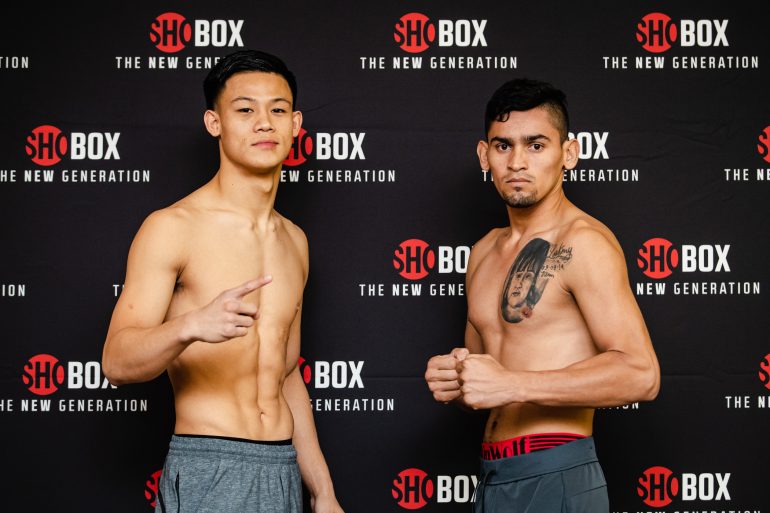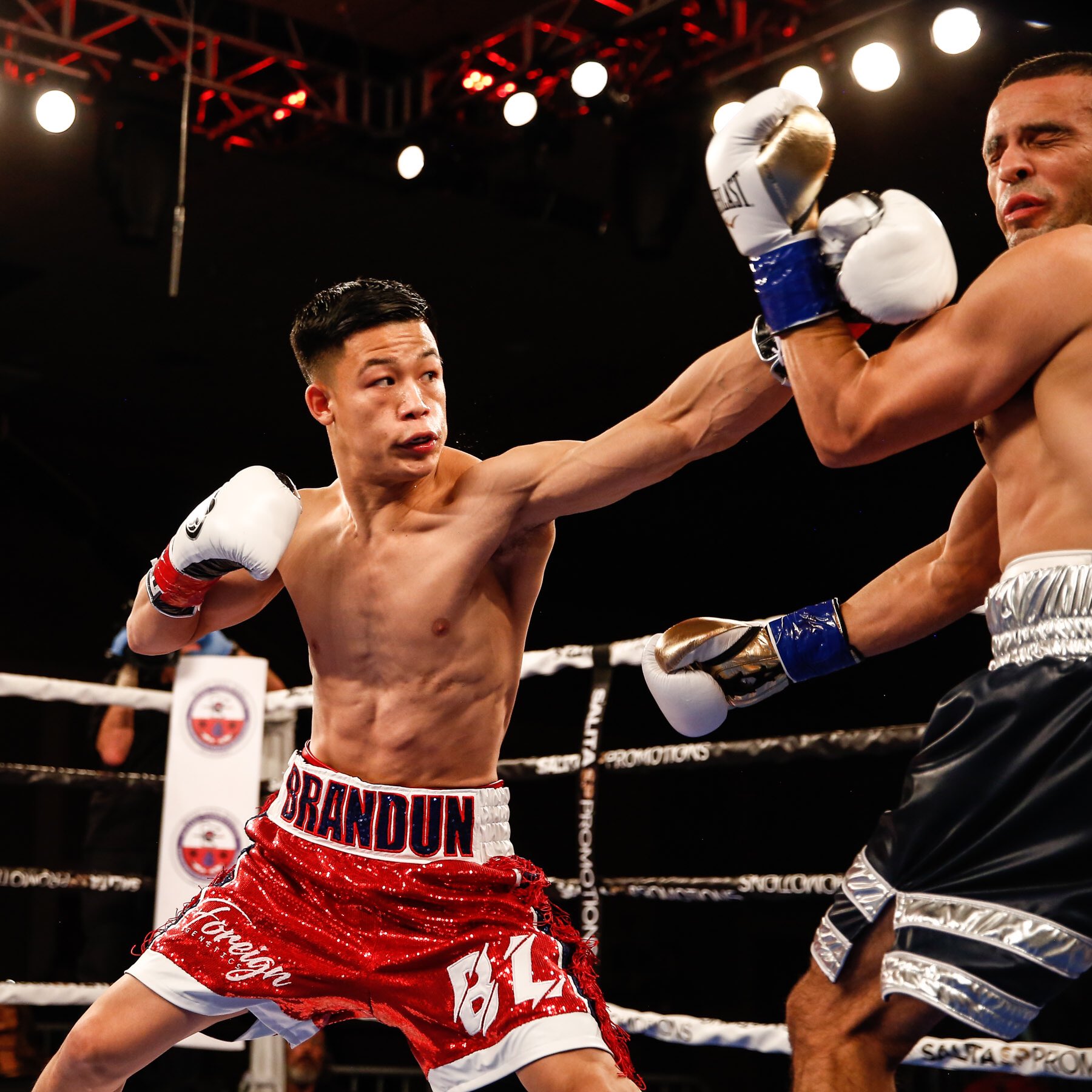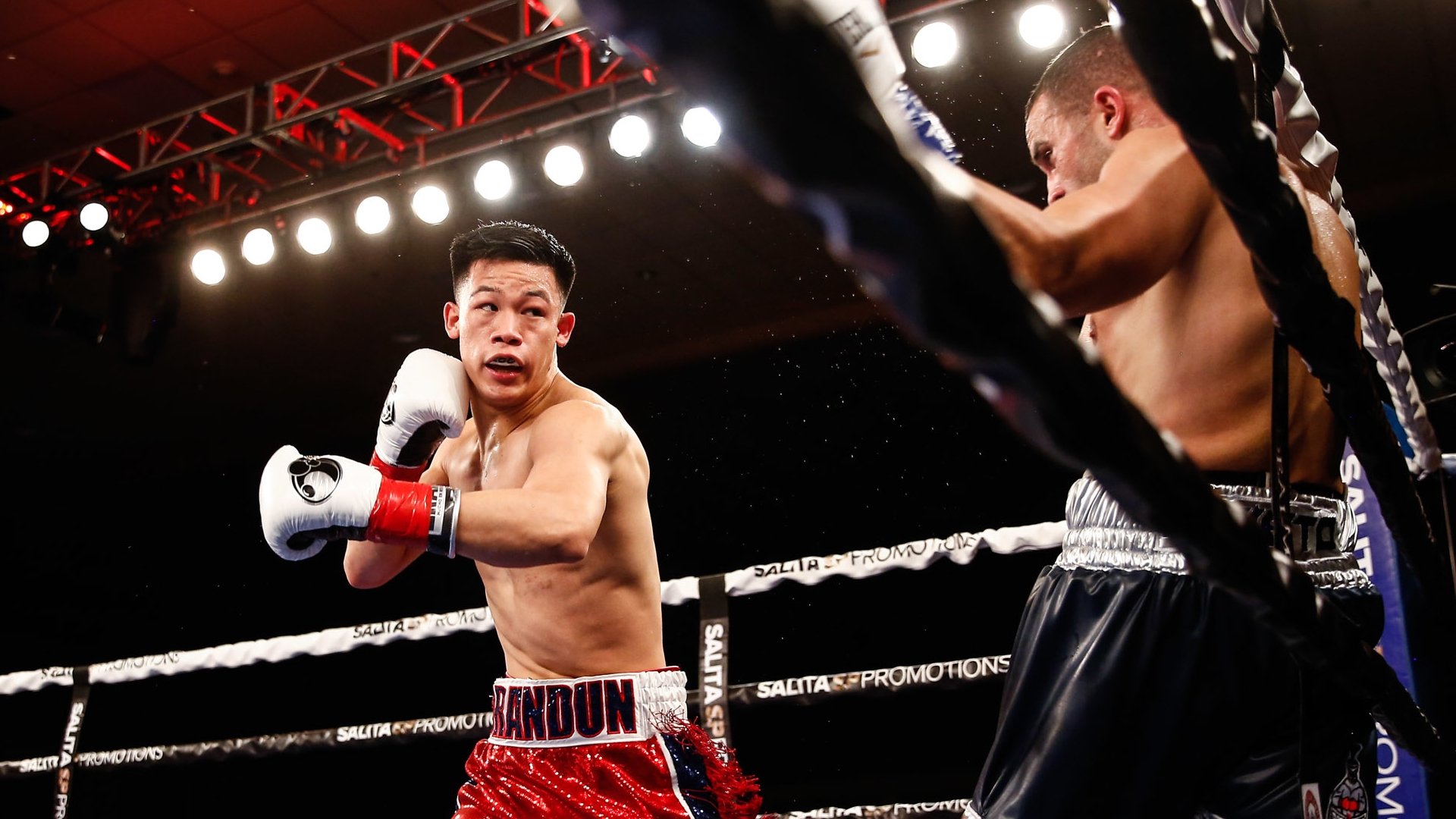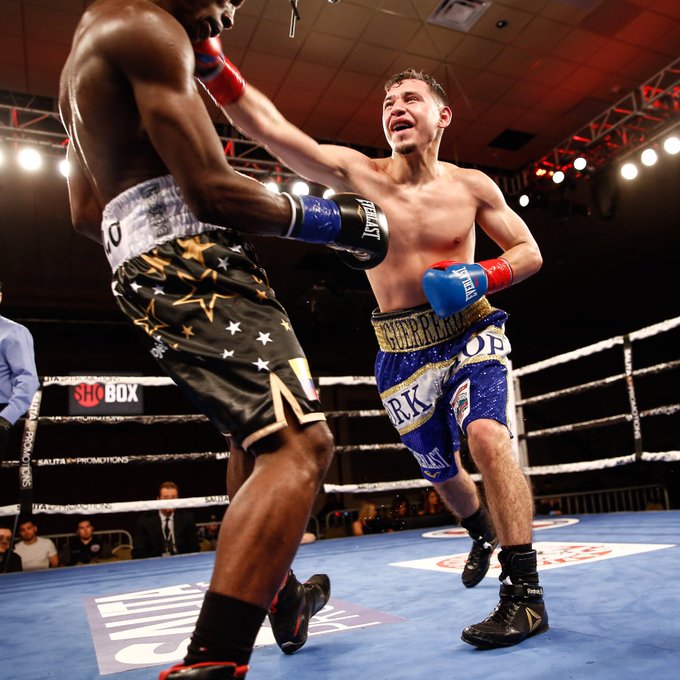The Travelin’ Man goes to Hinckley: Part Two

Please click here to read Part One.
Friday, March 13 (continued): A few hours before the fight card began, I approached Bobby Lee – the father and chief second of junior welterweight prospect Brandun Lee – to introduce myself and to pose a few questions about tonight’s main event against Miami-based Cuban Camilo Prieto.
He said he and manager Cameron Dunkin had formed a game plan designed to address a common complaint: Because the younger Lee’s matches ended so quickly, observers never got a good fix on how good he is and how good he may become. That is a valid argument, for the fighter’s 18-0 (with 16 KOs) record required only 30 rounds of ring action to build and included 11 first round knockouts, seven of which were accumulated in his last eight fights. The only fight in that stretch that didn’t end in Round One was his son’s only previous appearance on “ShoBox: The New Generation,” a second-round TKO over Milton Arauz last September in Midland, Texas.
Therefore the elder Lee said tonight’s intent was to box, display patience and strike only when the opportunity organically presented itself.
Mission accomplished.
Lee suppressed his natural urge to tear into his opponent for the first six minutes, then unleashed his inner tiger in Round Three. The markedly smaller, thicker and defensive-minded Prieto (who missed all 23 punches in Round One and all 13 power shots in Round Two) was unable to withstand the assault, prompting referee Mark Nelson to intervene at the 2:34 mark. Not only was this Lee’s longest outing since scoring a four-round unanimous decision win over the 3-40-4 Stephon McIntyre in May 2018, it also marked his 10th consecutive KO victory.
Statistically speaking, the effort was a great success. Averaging 67.4 punches per round to Prieto’s 35.3, Lee prevailed 53-9 in total connects, 17-8 in landed jabs and 36-1 in power connects while also prevailing 27%-9% overall, 17%-12% jabs and 40%-3% power. He also didn’t forget the body as he landed 22 punches to the flanks compared to Prieto’s six and a final indication of his dominance was that Lee landed more power punches in the fight (36) than Prieto dared to attempt (34).
As one might expect, the father/trainer was pleased with what he saw.

Brandun Lee (left) vs. Camilo Prieto. Photo courtesy of @ShowtimeBoxing on Twitter
“I saw what he was doing in the first round and after he came back (to the corner) in the second round, I told him, ‘Let’s try to get him out of there.’ I wanted him to walk him down a little bit quicker and do everything quicker.”
The fighter himself agreed with that account.
“The game plan was to make him miss in the first round to take his confidence,” he said. “I came back to the corner and my dad said, ‘He doesn’t want any more of this. Walk him down.’ I started to walk him down but I should have done it a little faster.”
Lee’s past numbers illustrate why he felt that way. In his three CompuBox-tracked fights against Francisco Medel, Arauz and Miguel Zamudio – fights that lasted a combined eight minutes and 40 seconds (six more seconds than tonight’s fight lasted) – Lee averaged 73.3 punches per round. In the one completed round in the sample – Round One versus Arauz – he fired 109 punches, landed 33 of them and connected on 25 of his 63 power shots. In Round One against Prieto, Lee tried just 41 punches, landing nine and went five of 12 in terms of power shots. Lee picked up the pace in Round Two (17 of 66 overall, 12 of 29 power) but he still had the look of a man who was purposefully holding back and a man who was aching to express his true self, especially against a smaller fighter who lacked the shot-for-shot impact to earn his respect.
In Round Three, he did just that.
“My father has a game plan for me – and, of course, I could listen to him – but I always have a ‘Plan B’ for myself,” Lee said. “He wanted me to get some rounds but, to be honest, no one wants to watch two guys looking at each other and messing around. So I want to apologize to all my fans, to my manager Cameron Dunkin and to my father for taking so long.”
Considering that Lee had averaged only 1.7 rounds per fight coming into tonight’s outing, eight minutes and 34 seconds of ring time would seem pedestrian, right? However the full-time college student had nothing for which to apologize; he did his job and he made it look easy. The differences in size, physique and power were overwhelming and he did what a heavily favored pugilist should have done in his first televised main event – establish his superiority, then close the show.
The numbers for Round Three captured the intensity with which he attacked. In the two minutes and 34 seconds it lasted, Lee was 27 of 86 overall, including eight of 37 in jabs and 19 of 49 in power punches. Had the round lasted the full three minutes, Lee would have fired 98 punches, close to the 109 he logged in Round One against Arauz.

Brandun Lee (left) vs. Camilo Prieto
Another part of the story regarding this performance was the surroundings in which the younger Lee operated: The event was closed to the general public due to concerns connected to the coronavirus pandemic and, as a result, fewer than 100 people were inside the Grand Casino Hinckley’s event center – all of whom were either fighters, family, support staff, media, officials or Showtime personnel. The event had the air of a media-day workout that only occurs before the mega-matches Lee wants for himself one day.
“It was a little odd,” Lee said when asked how he felt about fighting under these circumstances, “but I kind of liked it better because I could hear my father more; I could talk with my father more and I could communicate with him better.”
Theoretically at least, Lee and Prieto could hear not only their corner people but also the commentators seated approximately 15 feet from ringside. But did Lee?
“I could a little bit,” he said. “I heard (analyst Raul) Marquez say that I had a great jab but it was mostly a little vague because I was very focused.”
This was the fourth time I’ve watched Lee from a ringside perspective and he has cleared every hurdle with aplomb and flair. When counting Prieto’s March 2019 fight against Jose Anibal Cruz, I perceived him to be a technically competent operator but against Lee, he didn’t have the size or strength to keep his antagonist at bay. Prieto’s 15-2 (with 9 KOs) record is cosmetically better than Lee’s previous foes (his last five opponents had a combined 70-71-7, a .473 winning percentage) but inside the ring he was no match. By handling Prieto so easily, Lee showed he was ready to take the next leap up the ladder.
As much as we are enthralled by the talent we see in the ring, the internal intangibles separate the good from the great and only time – and higher-grade opponents – will reveal the athletic core that lies within.
One encouraging sign is the fact that Lee wants to pursue a master’s degree once he completes his current cycle of college studies (the second-year student is pursuing a degree in criminal justice) while also continuing to find time for his burgeoning boxing career. Excellence is difficult to achieve in a single pursuit but for Lee to shoot for that excellence in multiple fields is admirable – and perhaps revealing. I am looking forward to witnessing the next chapters of Lee’s story but given what is going on now we have no idea when the next installment will take place.
*
The predictably lopsided main event was preceded by a trio of excellent action fights. Yes, all the perceived “A-side” fighters emerged victorious but their counterparts offered stiff resistance and two of them performed well enough to earn a draw on one judge’s scorecard.
In logging a 10-round unanimous decision over Francisco Esparza last May, Moscow-based Armenian Aram Avagyan had to overcome a flash knockdown in Round Two, the product of a series of Esparza hooks to the head and body. In tonight’s fight against undefeated Dominican Dago Aguero, the 2016 Olympian pulled off an even more difficult feat as he managed to win an eight-round majority decision despite suffering knockdowns in each of the first two rounds. A pair of beautifully timed right crosses by the 2011 Pan-American Games silver medalist did the trick and with two 10-8 rounds against him (at least in theory), the chances of getting to an eighth round, much less winning a decision, were remote. But Avagyan managed to run the mathematical table and the foundation for his comeback was built in Round Three.
After being out-landed 55-24 overall and 51-20 power in the first six minutes, Avagyan upped his game in the next three by producing nearly identical numbers (26 of 73 overall and 26 of 63 jabs compared to Aguero’s 27 of 68 and 27 of 64 respectively) and did the same in Round Four (18 of 59 overall and 17 of 52 power to Aguero’s 20 of 63 and 16 of 47). Aguero, though still active, did not have the same snap and verve in those rounds but he caught a second wind of sorts in Round Five as he out-landed Avagyan 19-12 in a round that saw neither man landed a jab.
However the effort Aguero expended in Round Five apparently took its toll, for Avagyan swept the final three rounds in terms of total connects (83-50) and in power punches (80-48), allowing him to close to within 171-163 overall, 10-8 jabs and 161-155 power. Avagyan was slightly more accurate overall (33%-32%) and in power punches (39%-35%) and his surge enabled him to get within 5-3 in the CompuBox round-by-round breakdown of total connects.
Judge Mike Fitzgerald saw the fight 75-75 but counterparts Elijah Staples (77-74) and Tim Taggart Sr. (76-74) believed Avagyan had come all the way back from his early adversities and earned the right to advance his record to 10-0-1 (with 4 KOs). Staples’ score raised eyebrows because he scored the first round 10-9 for Aguero despite the knockdown and while some may credibly question Staples’ choice here, a 10-9 round featuring a knockdown is hardly unprecedented.
I have seen plenty of rounds in which a fighter won most of the round only to be floored and, in my mind, the two-point swing a knockdown usually produces should transform what would have been a 10-9 round for Fighter A into a 10-9 round for Fighter B. But some jurists automatically submit a 10-8 score no matter what occurred during the rest of the round, which would, in effect, produce a three-point swing instead of the usual two. That, I think, is faulty thinking because it denies Fighter A credit for controlling the rest of the round. I believe awarding a 10-9 score for Fighter B in that situation both honors the efforts of Fighter A during the majority of the stanza while also rewarding Fighter B by granting him a winning score in a round he otherwise would have lost.
Avagyan deserves much credit for his back-to-back off-the-floor wins and the resourcefulness he displayed in doing so but, going forward, one must wonder about the quality of his chin, especially in the early rounds. The good news for Avagyan is that there have been Hall of Fame fighters who overcame this vulnerability – Danny “Little Red” Lopez, Floyd Patterson and Ruben Olivares were three fighters who often were knocked down in the opening rounds – and there are even more outstanding champions who happened to be slow starters (Julio Cesar Chavez being one) so while a fighter like Avagyan warrants closer scrutiny, long-term goals can still be achieved.
As for Aguero, there was good reason to question the level of opposition that formed his 15-0 (with 10 KOs) record – his first 10 opponents had non-winning records and his last five foes were a combined 64-60-5 – but against Avagyan, he rose to the occasion by scoring those early knockdowns. However while Aguero ended up ahead on the stat sheets due to the massive gaps he created in the first six minutes, his energy level was not the same from Round Three onward. His hands were low and he lacked the physical strength to keep Avagyan from getting into his grill. His solution: Chronic clinching.
One measure of Avagyan’s ring generalship was that he imposed a fight in which power punching was king as it comprised 81.5% of the aggressive Avagyan’s output but also 85.7% of the counterpunching Aguero’s. At points, Avagan was manhandling Aguero and that visual probably accounted for the Armenian’s margin of victory on the cards of Staples and Taggart.
*
A similar boxer-aggressor pairing unfolded in the night’s second TV fight between lightweights Alejandro Guerrero and Jose Angulo and, like the opener, they produced a majority decision that favored the more aggressive fighter in Guerrero. Although both men fought beyond Round Six for the first time, they maintained an active pace (Angulo averaged 89.3 punches per round to Guerrero’s 68.9, well above the 59.1 lightweight average) and their demeanors and actions appeared sharp and energetic from start to finish.
Unlike Avagyan-Aguero, it was the initiator and not the counterpuncher who had the upper hand in the first two rounds as Guerrero – who carries the endearing nickname of “Pork Chop” – out-landed the angular Angulo 39-33 overall thanks to his 31-24 advantage in power connects. But the elongated Ecuadorian appeared to take control in Rounds Three through Six as he out-landed Guerrero 81-48 overall due to his increasingly effective jab (39-13) and his superior work rate (91.5 punches per round to Guerrero’s 59.3). If there were a swing round in this match, it was the seventh as both landed 21 total punches and the eighth round also challenged the judges as Angulo forged a 33-32 lead in overall connects while Guerrero pounded out a 28-25 edge in landed power punches.

Alejandro Guerrero (right) vs. Jose Angulo. Photo courtesy of Showtime Boxing
The pair combined for 208 total punches and 156 power shots in the last round but because of Angulo’s higher output throughout the match, he emerged with connect leads of 168-140 overall and 64-31 jabs while Guerrero forged a 109-104 advantage in landed power punches. The CompuBox round-by-round breakdown of total connects had Angulo ahead 5-2-1 but the official judges remained consistent in terms of favoring the man moving forward. John Mariano, in my eyes, was closest to the mark with his 76-76 scorecard, but he was overruled by Staples (79-73) and Taggart (78-74), whose margins for Guerrero were puzzling at the very least.
Both men showed well; Guerrero exemplified his “Pork Chop” persona with his TV-friendly attack and, given his risk-taking approach, his defensive numbers were good as Angulo landed 24% overall, 16% jabs and 32% power. Angulo, for his part, showed excellent movement, fired flashy combinations and demonstrated poise under fire.
Guerrero-Angulo produced a pleasing style mix, a compelling contest and a debate-worthy verdict. I wouldn’t mind seeing a rematch but that call is up to others to make.
*
Father-son pairings in boxing had long been considered bad news but the wave of successful partnerships has transformed that attitude to one of lesser skepticism, if not outright acceptance. Georgia welterweight Brian Norman Jr. is seconded by his father Brian Sr., who went 17-11 (with 5 KOs) during a career that spanned from 2003-2011. In tribute to his father, who was nicknamed “The Assassin,” Brian Jr.’s moniker is “The Assassin II.”
So far, he has lived up to the label as he entered the fight with a 16-0 (14) record that includes one no-contest as well as 10 first-round knockouts. But in examining this glossy record, one will see that 14 of his 17 opponents – including each of his first 12 – had non-winning records and that his last five foes had a combined record of 32-74-8, a .281 winning percentage.
Flavio Rodriguez is not trained by his own father but his chief second – Javier Capetillo Jr. – is the namesake son of the veteran Mexican trainer. While Norman’s generational story line is a familiar one, Rodriguez’s quest to return to boxing following a long break is also common in the sport. Following a successful professional debut at age 19, Rodriguez took a five-and-a-half-year break from the sport, blowing up to 230 pounds along the way. But Rodriguez returned to the gym, worked off the weight and resumed his career with a four-round unanimous decision over Julio Chiang in September 2015. Six more wins followed but he entered the Norman match on a 1-1-1 string capped by a six-round majority decision win over Gaku Takahashi in April 2019. Like Norman, his level of opposition hasn’t been statistically stellar as only three of his 11 opponents came into the fight off a win and his last five foes had a .400 winning percentage (26-37-2). Therefore, as is often the case with ShoBox fights, previously unseen intangibles were forced to the surface.
Through the first four rounds, Norman-Rodriguez was a near carbon-copy of the two fights that preceded it in terms of back-and-forth, viewer-friendly action with Norman being the man moving forward and Rodriguez alternating between circling and diving forward. Norman attacked the body well, especially in the first two rounds when body shots accounted for 20 of his 42 total connects. Rodriguez’s reddening flanks were evidence of how effectively Norman’s blows were landing.
Through four rounds, Norman created narrow connect gaps of 71-65 overall and 55-47 power to offset Rodriguez’s 18-16 lead in landed jabs while also producing a lively pace (68.5 punches per round for Norman, 54.8 for Rodriguez). But Norman started to separate himself from Rodriguez in Round Five as he prevailed 26-16 in total connects while landing 46% of his power punches (22 of 46) to Rodriguez’s 37% (13 of 35). He then turned on the jets in Round Six as he moved into the trenches, pushed Rodriguez toward the ropes and fired up-and-down bombs for nearly the entire round. Rodriguez did his best to fend him off as he threw 71 punches and 69 power shots but Norman’s 105 total punches and 91 power punches resulted in connect leads of 50-17 overall and 49-16 power.

Brian Norman Jr. (right) vs. Flavio Rodriguez. Photo courtesy of Showtime Boxing
Early in the seventh, an accidental butt opened a jagged vertical cut between Rodriguez’s eyes that resulted in the fight being stopped at the 57-second mark. The scorecards and the stat sheets were in sync as Norman ended the fight ahead 150-100 overall, 128-77 power and 6-1 in the CompuBox round-by-round breakdown of total connects while the officials saw Norman up 69-64 (Tim Taggart) and 68-65 (John Mariano, Patrick Morley).
From a punch-counter’s standpoint, the mechanics of working this show remained unchanged but the atmospherics were markedly different – at least for the televised portion of a card. I didn’t need to turn up the volume control on my headset very high to hear the announcers or the production truck because the only consistent yelling that occurred came from the trainers. The first two rounds of the main event were greeted by near silence as Lee and Prieto surveyed one another, increasing only when Lee unleashed the final volley of power shots that prompted referee Mark Nelson to intervene.
As I powered down my laptop, I saw that the Lees were still at ringside and, figuring this would be the best chance to talk with them, I left my work station – cell phone recorder in hand – got Bobby Lee’s attention and conducted the post-fight interview.
After talking with the Lees, this Lee indulged in some post-show pizza but because the hotel’s wireless internet system was still down, I was unable to enter the night’s numbers into the master database. CompuBox president Bob Canobbio told me the task could wait until tomorrow night if need be but I hoped the system would be fixed by tomorrow morning. (Note: It wasn’t.) As usual, the winding-down process took a while, for it wasn’t until 2 a.m. when I finally settled down.
Saturday, March 14: Because today’s first flight from Minneapolis to Charlotte is not scheduled to depart until 2:05 p.m., I was able to get in a full sleep cycle as well as a productive writing session before packing my belongings at 10:15 a.m. and leaving the hotel 15 minutes later. Aside from a chilly temperature of 21 degrees Fahrenheit, it was as nice a day to travel as I could have expected. I arrived at the airport shortly after noon, dropped off the rental vehicle, breezed through security, purchased a ham-and-cheese sandwich and a beverage and spent my time at the gate getting more writing done.
As I settled into my ninth-row window seat, I couldn’t help but notice how empty the cabin was. Most of the flights I take are filled to the gills but today, I saw that only five of the 18 seats in my immediate area were occupied. I had my three-seat section to myself and the man in the three-seat section across from me was the only person in his row. A mother and child were situated directly in front of me while the row across from them was completely empty. In the row directly behind me, one person occupied a window seat. While I appreciated the extra room, the feeling was eerie.
After the plane touched down in Charlotte, I was curious to see how many people were on this flight so I decided to stay behind and conduct an unofficial count. Of the 150 seats on this plane, only 88 (or 58.7%) were filled.
A strange incident occurred as the boarding process for my Charlotte-to-Pittsburgh flight began. A few minutes earlier, I made sure to have the screenshot of my mobile boarding pass ready but when the time came, I retrieved my phone and saw that the pass had vanished. I furiously looked through my picture gallery to find the pass but I could not find it. Moments after Group 4 passengers were asked to board, I retrieved the email that contained my original passes and saw that I had been switched to a First-Class seat. Usually I receive an email and text from American Airlines informing me that I had been upgraded but for the second straight time, American Airlines failed to do so. Ever the optimist, I chose to appreciate the fact that I received the upgrade at all.
The plane touched down in Pittsburgh at 7:38 p.m. and as I looked out the window, I noticed a light snow had just begun. The snowfall’s intensity increased as I approached my car but thankfully I arrived before any significant white stuff had accumulated.
The precipitation changed to rain after crossing into West Virginia and it was virtually gone by the time I arrived home shortly after 10:30 p.m. With that, an unusual and somewhat austere trip had come to an end.
Normally I would end this travelogue with a rundown of what comes next as far as where I would go and when but here, I have no idea about either. Given the cancellations of the other March 28 boxing cards, it’s a virtual guarantee that my scheduled trip to Las Vegas will not happen (Update: It was cancelled) and there is no word as to whether I (or my colleagues) would be able to work shows set for Grand Island, Nebraska, on April 10, Phoenix on April 18, Las Vegas on April 24 or Flint, Michigan, on May 9. (Update: The April 10 and 18 shows were called off.) As of this writing, West Virginia is the only state in the union that has no known coronavirus cases but, given the odds, that will change. As of this writing, I am feeling fine and I hope that will remain the case going forward.
As I stated in Part One, I will approach this issue with respect and without panic. I have plenty of work to keep me busy and I’m more than comfortable with the proposition of working inside the Home Office for an extended period. Facts are facts: This is our new reality until a breakthrough occurs – and I have full faith that a breakthrough will happen – it’s just a matter of when.
So until next time – whenever that may be – happy trails!
*
Lee Groves is a boxing writer and historian based in Friendly, West Virginia. He is a full member of the BWAA, from which he has won 16 writing awards, including two first-place awards, since 2011. He has been an elector for the International Boxing Hall of Fame since 2001 and is also a writer, researcher and punch-counter for CompuBox, Inc. He is the author of “Tales from the Vault: A Celebration of 100 Boxing Closet Classics” (available on Amazon) and the co-author of “Muhammad Ali: By the Numbers” (also available on Amazon). To contact Groves about a personalized autographed copy, use the email [email protected] or send him a message via Facebook.
Struggling to locate a copy of The Ring Magazine? Try here or
Subscribe
You can order the current issue, which is on newsstands, or back issues from our subscribe page.















